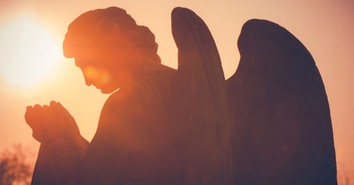Beasts of the Southern Wild a Stunning Debut

DVD Release Date: December 4, 2012
Theatrical Release Date: June 27, 2012
Rating: PG-13 (for thematic material including child imperilment, some disturbing images, language and brief sensuality)
Genre: Drama
Run Time: 91 min.
Director: Benh Zeitlin
Cast: Quvenzhané Wallis, Dwight Henry, Levy Easterly
“I see everything that made me flying around in invisible pieces.”
Gritty Realism is nothing new in movies, but I don’t know if I’ve ever seen anything that could be described as Gritty Surrealism—until now. The jarring rawness of recent neo-realistic works is so seamlessly, even organically, married to a level of visual and philosophical poetry that it creates, well, if not an entirely new cinematic language then at least a new accent of stylistic multi-aestheticism the likes of which we’ve never seen before.
Director Benh Zeitlin’s first feature is nothing short of stunning, and while his cinematic inspirations are easy to spot (from Terrence Malick’s elegiac tone to the dreamlike visions of Spike Jonze and Charlie Kaufman) his eye is no less distinct. Beasts of the Southern Wild boasts a major new voice in American cinema, one that holds as much promise as any debut in memory.
Set in the swampy Louisiana delta, it’s the story of a resilient 6-year-old African-American girl named Hushpuppy and her violent-but-sick father Wink. They live out in the trees of the marshland, in shacks constructed of old trailers, vehicles, and patchwork junk. It’s a place with no address, in a community called The Bathtub (one built from rubbish and squalor); a district so far out on the margins its existence is not recognized by society. It truly is The Southern Wild. And when a hurricane hits, beasts both human and animal are driven from their habitats in a desperate fight for survival.
“Sometimes you can break something so bad that it can’t get put back together.”
Beasts of the Southern Wild is an intimate story of extreme poverty that becomes epic. While the narrative centers around the tumultuous but loving relationship between Hushpuppy and her father, there’s also a much broader vision unfolding—visually, narratively, thematically—that ponders the balance of nature in both its awesome strength and tenuous fragility, seeing that tension depicted on a grand scale, and the courage it takes to face a broken and brutal world.
It’s a world we see solely from Hushpuppy’s perspective, both in how we receive the narrative and perceive events. We don’t know what happened to her mother, we just know she’s not there. We don’t know what Wink is slowly dying from but simply that he is. And we don’t know if the hurricane is actually Katrina but it might as well be. Specified details are unimportant because the core dynamics speak to more universal things about the human condition and life as we know it.
Hushpuppy largely fends for herself. She’s tough but in a very matter-of-fact way, maintaining a purity in spite of circumstances. We hear her thoughts, and they’re lyrical. It’s through those thoughts that Zeitlin speaks his own mind and constructs metaphors—about the environment, the destructive cycles of nature (both man-made and naturally occurring), how we cope with destruction and death both individually and communally, and how external and internal beauty can be found in the midst of it all (even if only in fleeting yet substantial moments).
“Everybody loses the thing that made them.”
Wink is a drunk, a state fueled by bitterness at the cruelty he’s faced, and that’s often expressed in anger and abuse toward Hushpuppy. Yet he is a complex character as well, because underneath that unforgiving exterior is the motive to make his daughter tough enough for the world that has beaten him down. He stresses anger and rage because those are the survival skills he knows. His meanness is his expression of love to Hushpuppy, though not limited to it.
That we sense this depth and feel compassion for Wink is to the credit of both Zeitlin’s direction and first-time actor (baker by trade) Dwight Henry. These complexities emerge primarily through portrayal and that is a real feat, especially considering Henry’s complete inexperience in the craft. Key moments of dialogue evoke that depth as well, from views philosophical and practical (like “My only purpose in life is to teach her how to make it”—a realization both hard and loving). It is a towering, unforgettable performance.
“They think we’re gonna drown down here. But we ain’t going nowhere.”
Equally remarkable as Hushpuppy is young Quvenzhané Wallis, especially since so many of the film’s big ideas are embodied in her. Her age provides an innocence that actually gives those ideas more authority, and Wallis imbues an effortless integrity into every thought and moment. She has a strength beyond her years.
Zeitlin depicts this fringe world not only with stark veracity but, at times, with ethereal beauty. It’s such an odd combination of styles that Zeitlin blends, the result of which feels like some highly impressionistic documentary. The flavors of realism are buoyed by real locales and a cast of locals. Zeitlin went so far as to let his amateurs be themselves, even when it meant completely changing how their roles were scripted. We feel that authenticity; it’s right there on the screen.
That realism is then transformed into the fantastical with bold strokes of imagination and invention. They begin subtlety with truck beds turned make-shift boats that sail down river, then to more heavily art-directed constructs like a roof converted into a survivors' floating pontoon, and most eerily the recurring metaphor of gigantic wild boars barreling through homes leaving death and destruction in their wakes.
“Strong animals know when your hearts are weak.”
When that metaphor becomes reality in a climactic confrontation, the result is one of the most striking images (and breathtaking moments) I’ve seen in years. It visualizes what the film is really all about: the courage to stand up to the beast, show it you’re not afraid, and even stare it down. Not out of righteous indignation but a simple conviction that every life matters.
Beasts of the Southern Wild is a dark fairy tale that heightens reality in order to reveal it. In the end, it’s not just about survival from some environmental apocalypse but also the resurrection that emerges from it, in the lives of those willing to face the beasts and the children of those who, though they may have lost the fight, instilled a legacy.
“I see that I am a little piece of a big, big universe—and that makes it right.”
CAUTIONS:
- Drugs/Alcohol Content: Drinking of beer and whiskey, inebriation, both individually and in a group.
- Language/Profanity: Four A-words, two S-words, two uses of the Lord’s name in vain, and two instances of the P-word feminine sexual slang used as an epithet for weakness.
- Sexual Content/Nudity: Women in lingerie slips and gowns, at a makeshift brothel (no nudity or sexuality). Bare back of a topless woman.
- Violence/Other: Dad slaps girl, knocks her down; also verbally abusive. Spilled gutted entrails of a dead animal. Conditions of extreme poverty are unsettling. Violent peril in the midst of a hurricane. A sick man coughs up blood.
Crosswalk.com Movies: Beasts of the Southern Wild from crosswalkmovies on GodTube.
Originally published June 29, 2012.







